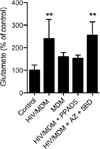Adenosine triphosphate released from HIV-infected macrophages regulates glutamatergic tone and dendritic spine density on neurons
- PMID: 23686368
- PMCID: PMC3740066
- DOI: 10.1007/s11481-013-9471-7
Adenosine triphosphate released from HIV-infected macrophages regulates glutamatergic tone and dendritic spine density on neurons
Abstract
Despite wide spread use of combination antiretroviral therapy (cART) in developed countries, approximately half of HIV-infected patients will develop impairments in cognitive function. Accumulating evidence suggests that neuronal dysfunction can be precipitated by HIV-infection of macrophages by mechanisms that involve alterations in innate and adaptive immune responses. HIV-infection of macrophages is known to increase the release of soluble neurotoxins. However, the composition of products released from infected macrophages is complex and not fully known. In this study we provide evidence that ATP and other immuno-/neuromodulatory nucleotides are exported from HIV-infected macrophages and modify neuronal structure. Supernatants collected from HIV-infected macrophages (HIV/MDM) contained large amounts of ATP, ADP, AMP and small amounts of adenosine, in addition to glutamate. Dilutions of these supernatants that were sub-threshold for glutamate receptor activation evoked rapid calcium flux in neurons that were completely inhibited by the enzymatic degradation of ATP, or by blockade of calcium permeable purinergic receptors. Applications of these highly diluted HIV/MDM onto neuronal cultures increased the amount of extracellular glutamate by mechanisms dependent on purinergic receptor activation, and downregulated spine density on neurons by mechanisms dependent on purinergic and glutamate receptor activation. We conclude from these data that ATP released from HIV-infected macrophages downregulates dendritic spine density on neurons by a mechanism that involves purinergic receptor mediated modulation of glutamatergic tone. These data suggest that neuronal function may be depressed in HIV infected individuals by mechanisms that involve macrophage release of ATP that triggers secondary effects on glutamate handling.
Conflict of interest statement
The authors have no conflicts of interest or competing interests to disclose.
Figures






Similar articles
-
Glutaminase-containing microvesicles from HIV-1-infected macrophages and immune-activated microglia induce neurotoxicity.Mol Neurodegener. 2015 Nov 6;10:61. doi: 10.1186/s13024-015-0058-z. Mol Neurodegener. 2015. PMID: 26546362 Free PMC article.
-
Induction of Heme Oxygenase-1 Deficiency and Associated Glutamate-Mediated Neurotoxicity Is a Highly Conserved HIV Phenotype of Chronic Macrophage Infection That Is Resistant to Antiretroviral Therapy.J Virol. 2015 Oct;89(20):10656-67. doi: 10.1128/JVI.01495-15. Epub 2015 Aug 12. J Virol. 2015. PMID: 26269184 Free PMC article.
-
ATP and glutamate are released from separate neurones in the rat medial habenula nucleus: frequency dependence and adenosine-mediated inhibition of release.J Physiol. 1998 May 1;508 ( Pt 3)(Pt 3):691-701. doi: 10.1111/j.1469-7793.1998.691bp.x. J Physiol. 1998. PMID: 9518726 Free PMC article.
-
Bidirectional astrocyte-neuron communication: the many roles of glutamate and ATP.Novartis Found Symp. 2006;276:208-17; discussion 217-21, 233-7, 275-81. doi: 10.1002/9780470032244.ch16. Novartis Found Symp. 2006. PMID: 16805432 Review.
-
Role of immune activation and cytokine expression in HIV-1-associated neurologic diseases.Adv Neuroimmunol. 1995;5(3):335-58. doi: 10.1016/0960-5428(95)00012-q. Adv Neuroimmunol. 1995. PMID: 8748077 Review.
Cited by
-
Putative roles of purinergic signaling in human immunodeficiency virus-1 infection.Biol Direct. 2014 Oct 29;9:21. doi: 10.1186/1745-6150-9-21. Biol Direct. 2014. PMID: 25351961 Free PMC article.
-
Purinergic Receptors: Key Mediators of HIV-1 Infection and Inflammation.Front Immunol. 2015 Nov 26;6:585. doi: 10.3389/fimmu.2015.00585. eCollection 2015. Front Immunol. 2015. PMID: 26635799 Free PMC article. Review.
-
Human iPSC-derived neurons reveal NMDAR-independent dysfunction following HIV-associated insults.Front Mol Neurosci. 2024 Jan 29;16:1353562. doi: 10.3389/fnmol.2023.1353562. eCollection 2023. Front Mol Neurosci. 2024. PMID: 38348237 Free PMC article.
-
Astrocyte-shed extracellular vesicles regulate the peripheral leukocyte response to inflammatory brain lesions.Sci Signal. 2017 Apr 4;10(473):eaai7696. doi: 10.1126/scisignal.aai7696. Sci Signal. 2017. PMID: 28377412 Free PMC article.
-
Damage/Danger Associated Molecular Patterns (DAMPs) Modulate Chlamydia pecorum and C. trachomatis Serovar E Inclusion Development In Vitro.PLoS One. 2015 Aug 6;10(8):e0134943. doi: 10.1371/journal.pone.0134943. eCollection 2015. PLoS One. 2015. PMID: 26248286 Free PMC article.
References
-
- Brew BJ, Corbeil J, Pemberton L, Evans L, Saito K, Penny R, Cooper DA, Heyes MP. Quinolinic acid production is related to macrophage tropic isolates of HIV-1. J Neurovirol. 1995;1:369–374. - PubMed
-
- Chen W, Sulcove J, Frank I, Jaffer S, Ozdener H, Kolson DL. Development of a human neuronal cell model for human immunodeficiency virus (HIV)-infected macrophage-induced neurotoxicity: apoptosis induced by HIV type 1 primary isolates and evidence for involvement of the Bcl-2/Bcl-xL-sensitive intrinsic apoptosis pathway. J Virol. 2002;76:9407–9419. - PMC - PubMed
Publication types
MeSH terms
Substances
Grants and funding
LinkOut - more resources
Full Text Sources
Other Literature Sources

